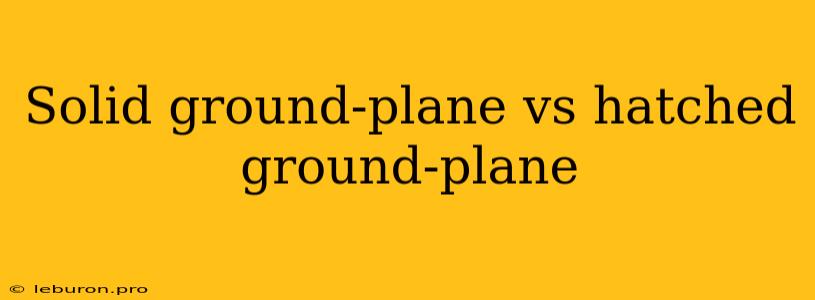The design of printed circuit boards (PCBs) involves numerous considerations, one of which is the implementation of a ground plane. A ground plane serves as a reference point for signal integrity, ensuring proper grounding and reducing noise. Two common approaches to ground plane design are the solid ground-plane and the hatched ground-plane. While both offer advantages, understanding the distinctions between these methods is crucial for optimizing PCB performance and mitigating potential issues. This article delves into the characteristics, benefits, drawbacks, and applications of solid ground-planes and hatched ground-planes, providing a comprehensive guide for PCB designers to make informed decisions.
Solid Ground-Plane: Advantages and Limitations
A solid ground-plane consists of a continuous, uninterrupted copper layer covering the entire surface of a PCB layer. This method is widely used due to its inherent simplicity and effectiveness in reducing noise and improving signal integrity.
Advantages of Solid Ground-Planes:
- Enhanced Signal Integrity: The solid copper layer provides a low-impedance path for return currents, effectively minimizing signal reflections and noise. This is particularly beneficial for high-speed digital circuits where signal integrity is paramount.
- Improved Thermal Dissipation: The continuous copper surface acts as a heat sink, enhancing heat dissipation from components and reducing operating temperatures.
- Reduced EMI/RFI: The solid ground-plane acts as a shield, effectively minimizing electromagnetic interference (EMI) and radio frequency interference (RFI). This is essential in applications sensitive to electromagnetic noise.
- Simplified Routing: The uniform surface of a solid ground-plane makes it easier to route traces, reducing the complexity of layout design.
Disadvantages of Solid Ground-Planes:
- Increased Copper Consumption: Due to the use of a complete copper layer, solid ground-planes require a larger amount of copper, which can increase material costs.
- Reduced Flexibility: The rigid nature of the solid ground-plane can limit design flexibility, especially in areas where components need to be placed close together.
- Possible Manufacturing Challenges: Large areas of copper can pose challenges during manufacturing, requiring precise etching and processing to ensure accuracy.
Hatched Ground-Plane: Balancing Performance and Cost
A hatched ground-plane utilizes a pattern of interconnected copper traces, forming a mesh-like structure. Unlike a solid ground-plane, it does not completely cover the entire surface, allowing for a more cost-effective use of copper.
Advantages of Hatched Ground-Planes:
- Reduced Copper Consumption: By utilizing a pattern of traces, hatched ground-planes can significantly reduce the amount of copper required, resulting in lower material costs.
- Increased Flexibility: The open areas in the hatched ground-plane provide more flexibility for component placement and routing, allowing for denser designs.
- Improved Thermal Management: The open areas in the hatched ground-plane can improve airflow, facilitating better thermal dissipation and reducing component temperatures.
- Reduced Manufacturing Costs: The reduced copper consumption and simpler processing requirements associated with hatched ground-planes can lower manufacturing costs.
Disadvantages of Hatched Ground-Planes:
- Compromised Signal Integrity: The discontinuous nature of the hatched ground-plane can lead to higher impedance paths for return currents, potentially degrading signal integrity.
- Increased Noise Susceptibility: The open areas in the hatched ground-plane can allow for greater noise ingress, increasing susceptibility to EMI/RFI.
- Complex Design and Layout: Creating an effective hatched ground-plane requires careful design and layout considerations to ensure proper grounding and minimize noise.
- Potential for Ground Bounce: If the pattern of traces in the hatched ground-plane is not carefully designed, it can contribute to ground bounce, leading to signal distortion.
Applications of Solid and Hatched Ground-Planes
The choice between a solid ground-plane and a hatched ground-plane depends largely on the specific application requirements and design constraints.
Solid Ground-Planes are ideally suited for:
- High-speed digital circuits: Their ability to minimize signal reflections and noise makes them essential for applications requiring high data rates and low jitter.
- EMI/RFI sensitive applications: The shielding effect of the solid copper layer provides excellent protection against electromagnetic noise.
- Applications requiring high thermal dissipation: The continuous copper surface acts as an effective heat sink, reducing component operating temperatures.
Hatched Ground-Planes are often used in:
- Cost-sensitive applications: The reduced copper consumption offers significant cost savings.
- Designs with limited space: The flexibility in component placement and routing allows for denser layouts.
- Applications requiring thermal management: The open areas in the hatched ground-plane can facilitate better airflow and improve thermal dissipation.
Conclusion
The choice between a solid ground-plane and a hatched ground-plane is a crucial consideration in PCB design. Both approaches offer advantages and disadvantages, making the selection dependent on specific application requirements. Solid ground-planes excel in high-speed digital circuits, EMI/RFI sensitive applications, and those demanding high thermal dissipation. However, their higher copper consumption and reduced flexibility can be drawbacks. Hatched ground-planes offer cost savings and flexibility but compromise signal integrity and noise immunity. By carefully evaluating the pros and cons of each approach, PCB designers can optimize their designs for optimal performance, cost-effectiveness, and reliability.
